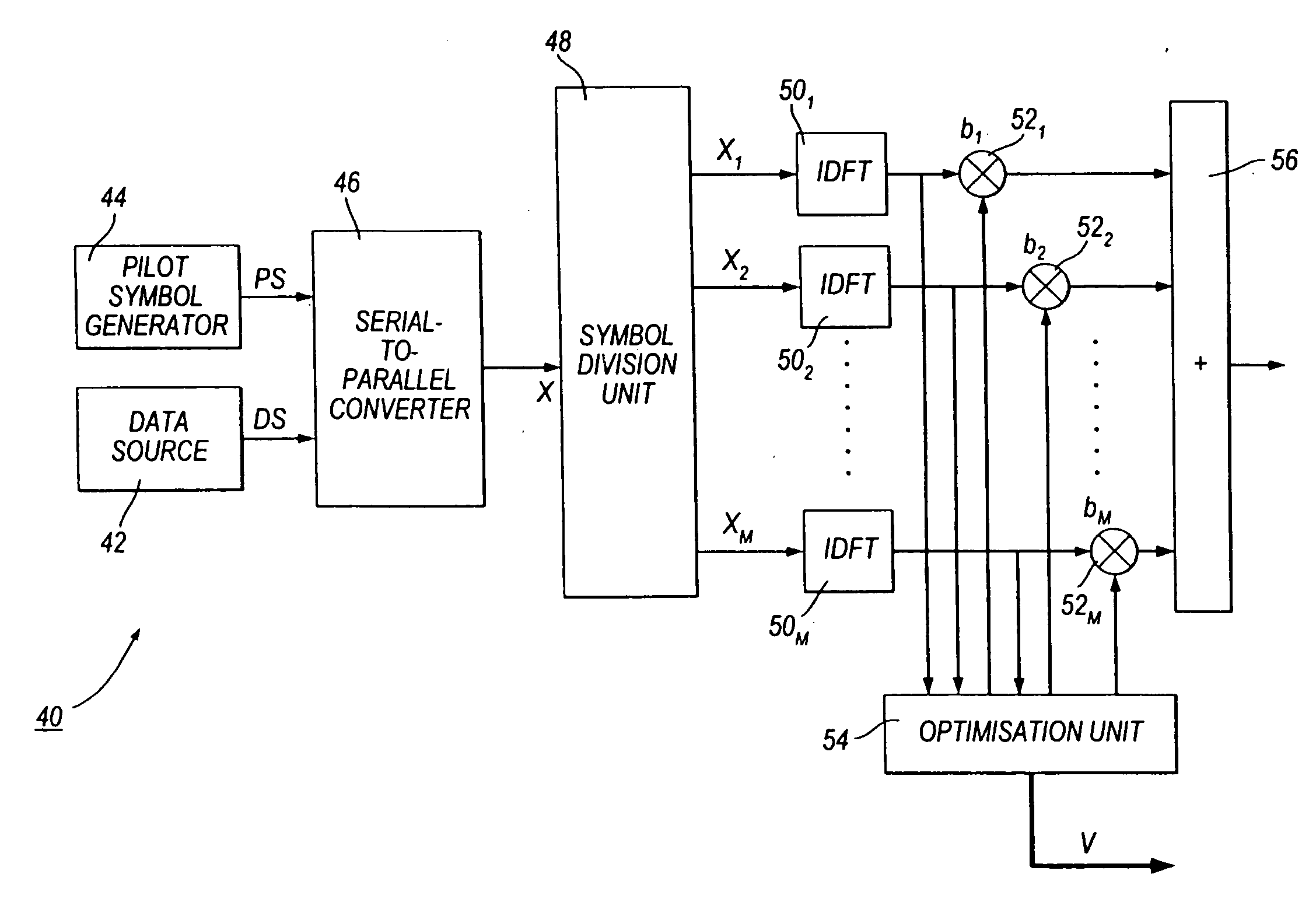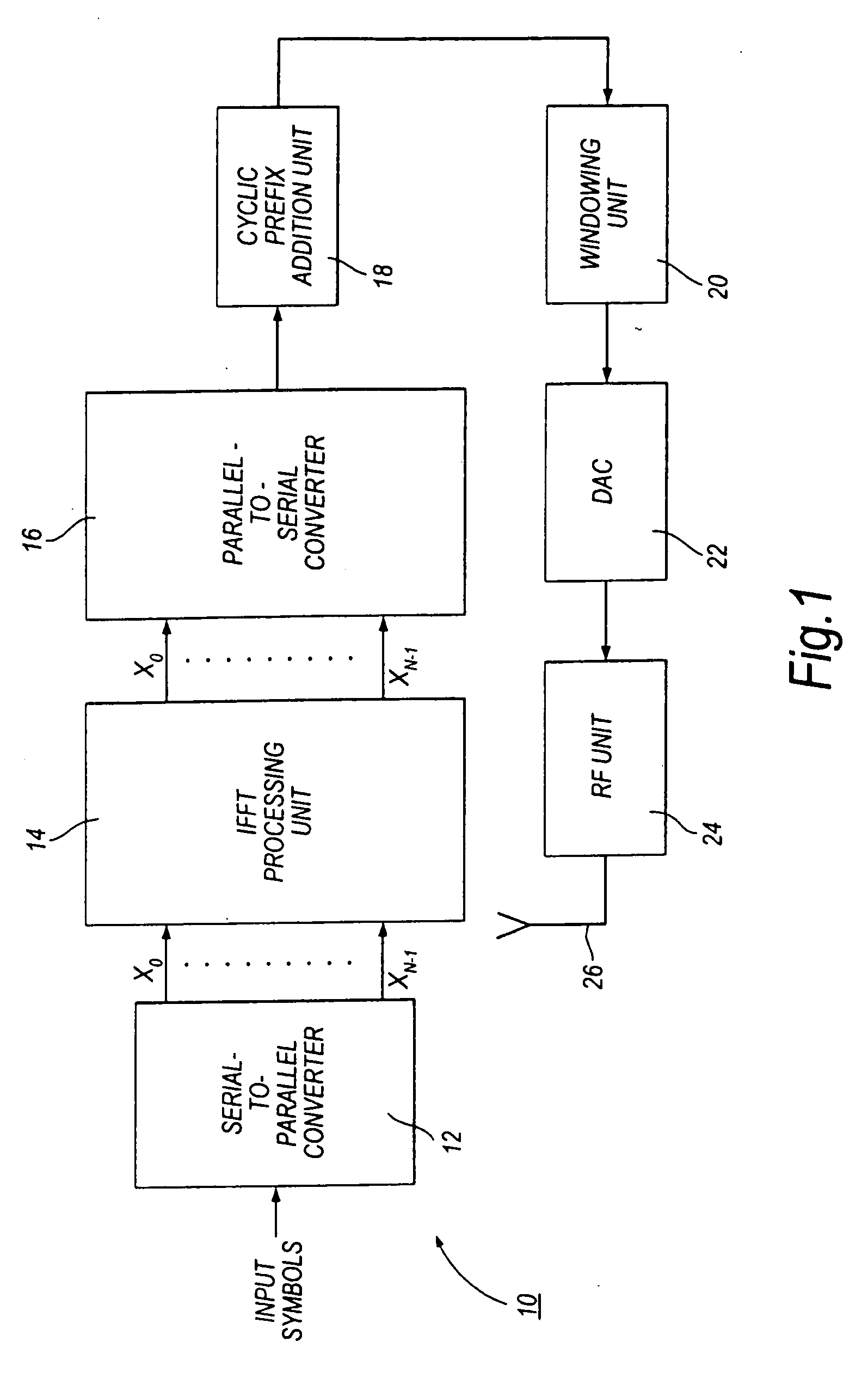OFDM communication systems, transmitters and methods
a communication system and transmitter technology, applied in the field of orthogonal frequency division multiplexing (ofdm) communication systems and methods, can solve the problems of loss of orthogonality of sub-carriers, high peak-to-average power ratio (hereinafter papr), and large dynamic range in the transmitter, so as to achieve better performance
- Summary
- Abstract
- Description
- Claims
- Application Information
AI Technical Summary
Benefits of technology
Problems solved by technology
Method used
Image
Examples
first embodiment
[0145]FIG. 5 shows parts of an OFDM transmitter according to the present invention. In this embodiment, it is assumed that the transmitter is adapted for wireless communication, but embodiments of the present invention are also applicable to communication systems having a wire connection between the transmitter and the receiver. The transmitter 100 is, for example, a node B of a wireless communication system, and the receiver (not shown) is, for example, a user equipment (UE) of such a wireless communication system.
[0146] In FIG. 5, elements which are the same as elements of the FIG. 1 transmitter described hereinbefore have been given the same reference numerals. The transmitter of FIG. 5 differs from the transmitter of FIG. 1 in that it includes a data allocation unit 102 and a control unit 104.
[0147] As in the FIG. 1 transmitter, a serial-to-parallel converter 12 receives serial input symbols which, in this embodiment, are assumed to comprise both data symbols DS and pilot symbo...
second embodiment
[0160] The use of circular data allocation as in the second embodiment has a number of advantages. A first advantage is that because the number of rotations is N, the maximum number of available allocations requiring calculation is also N, which is usually desirably small. Of course, not all possible rotation values need to be available. For example, the number of available rotations could be restricted to less than N. A second advantage is that the circular data allocation unit 112 can be implemented, either in hardware or in software, in a very simple manner. A third advantage is that, because the number of available rotations is at most N, the signalling overhead to signal the rotation value RCDA to the receiver (if required) as side information can be desirably small.
[0161] A further advantage which can be achieved when the allocations of input symbols to sub-carriers are rotations will be explained with reference to FIG. 7.
[0162] Firstly, referring to FIG. 6, the circular data...
third embodiment
[0173] The basic operation of the third embodiment is illustrated in FIG. 9. FIG. 9 shows how the group of input symbols and the rotational pilot symbol PSrot are allocated to the N sub-carriers for each of the rotation values r=0, r=1 and r=2. As can be seen from FIG. 9, when r=0, the rotational pilot symbol PSrot appears as symbol output RX0 and is allocated to sub-carrier 0. When r=1, the rotational pilot symbol PSrot appears as symbol output RX1 and is allocated to sub-carrier 1. When r=2, the rotational pilot symbol PSrot appears as symbol output RX2, and is allocated to sub-carrier 2. The group of N-2 input symbols (which, as noted above may include regular pilot symbols PSreg as well as data symbols) appear in order on the remaining sub-carriers following the sub-carrier to which the rotational pilot symbol PSrot is allocated.
[0174] At the or each receiver, as described later in more detail, the received signal is subjected to N-point fast Fourier transform (FFT) processing t...
PUM
 Login to View More
Login to View More Abstract
Description
Claims
Application Information
 Login to View More
Login to View More - R&D
- Intellectual Property
- Life Sciences
- Materials
- Tech Scout
- Unparalleled Data Quality
- Higher Quality Content
- 60% Fewer Hallucinations
Browse by: Latest US Patents, China's latest patents, Technical Efficacy Thesaurus, Application Domain, Technology Topic, Popular Technical Reports.
© 2025 PatSnap. All rights reserved.Legal|Privacy policy|Modern Slavery Act Transparency Statement|Sitemap|About US| Contact US: help@patsnap.com



